
Q: Here is a very heavy, 17-inch tall Indian mask carved out of a hunk of wood. What do you think… is this piece ethnographic or tourist? Nate, 560
A: Ethnographic Indian for sure. But I don’t know where in India it is from or what use it was intended for. I hope someone will help us out. I can find no books on Indian masks. It surprises me that so little interest is shown in Indian masks. It is the second largest country in the world and it has a very rich history of folk art. Interest in these traditions may start soon, just as it has recently in China.
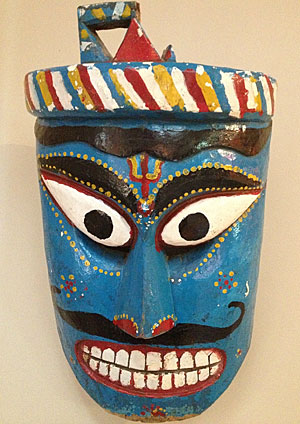
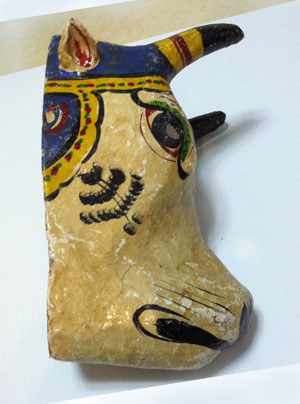

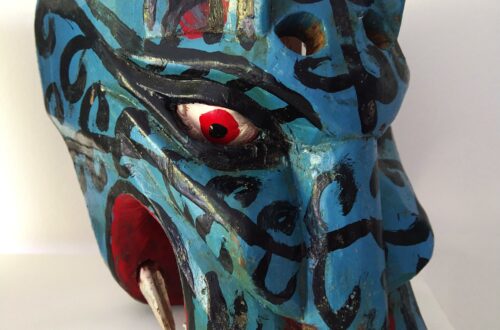
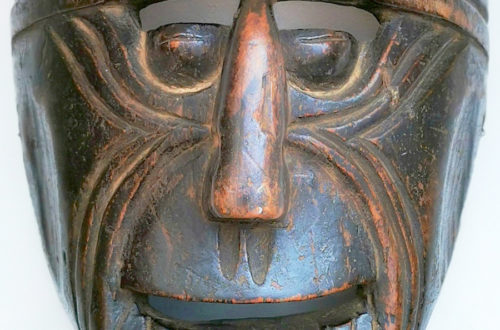
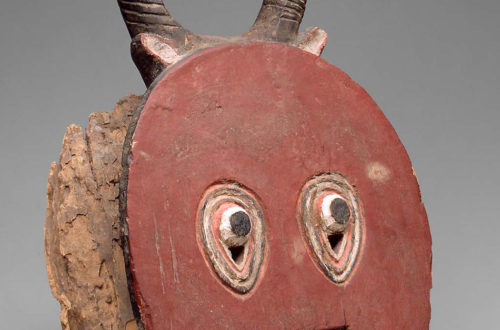
6 Comments
Nate
Bob, I have since found out that this is S. Indian. It is a Hindu mask. Its of no surprise since S. India sits just above the Island of Sir Lanka that this mask has alot of characteristics of Sri Lanka such as the square peg-holes on the sides that would have at one point attached some sort of “wings” as typically seen on Sri Lankan masks. Its also deep carved, heavy, and over-sized as many of those are. To my knowledge its mid-century, probably 1960s.
Bob Ibold
We are getting a little closer on this mask. If someone knows about a book or website with a lot of info on Indian masks, please let us know.
GIROLAMI Jean-Pierre
I know well this kind of mask , it is coming Rajbansi , Dhimal tribes from Orissa . These masks are still used but less and less for Ramayana plays. Cotation mid century is correct but it might much more older as these masks are often repainted. Looking at the inside gives a better idea. I agree that with the little interest of collectors …but the good side is that you can found very interesting mask for reasonable price
Books : Unknown Master pieces of Indian Folk and Tribal art by Subhashini Aryan ISBN 81-901933-0-9
World of other faces indian masks by Jiwan Pani Publication Division ministry of information Gov of India , no ISBN
Ethnoflorence
On my not commercial blog there are information and pictures, in Mechinagar, a Nepalese village border line with India, there is an indigenous cultural festival dedicated especially to the culture of the Rajbansi people. http://ethnoflorence.skynetblogs.be/
Henry
I saw a mask very similar to this mask when I was researching other types of Indian masks. Apparently, this mask represents living spirits of the dead that remain in the over world. I would say 1970s ethnographic.
Alain Rouveure
This mask comes from Southern Nepal border with India, made and used by Rajbansi people during the story telling of the Ramayana. Jean Pierre, above, was absolutely right. I have been collecting masks from the Himalayas since 1979 and have over 100 pieces from this same area in my collections. The mask you have is old, probably late19th/early 20th Cent and the paint is of course new. That is what people would do. Villagers would repaint their sets of masks regularly before the festival and story telling.
This particular mask looks like Ravana (the bad King of Lanka who kidnapped Sita, wife of Ram – the story of Ram-ayana) imitating the God Shiva during one of the long and complicated battles of wits.
Typical mask, beautiful and strong, genuinely old and very decorative.
Indian TV channels show the Ramayana regularly. There are digital special effect that people love much better than the old story told with masks and musicians in small communities of Southern Nepal and India.
Masks from this area are very undervalued, not just financially, but certainly culturally, which is a great shame. It is more and more difficult to find old genuine masks as they are rarely used nowadays and few are still made today (that will be antiques tomorrow). There are more and more fakes appearing on the market in Kathmandu, Nepal, making their way to the West. Beware.
It is a great shame, but Life goes on.
I hope this is useful. All best wishes. Alain